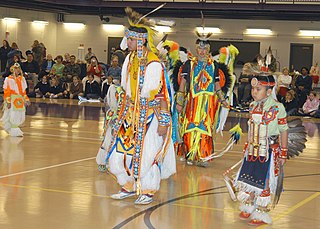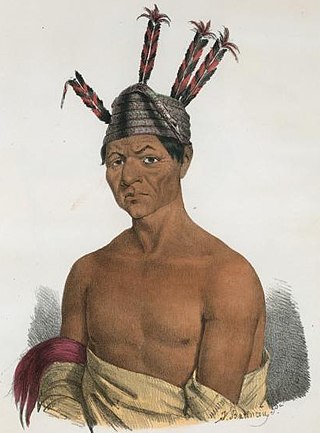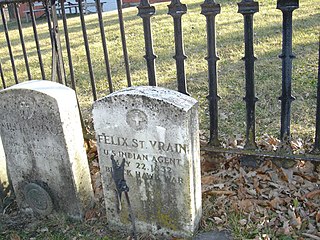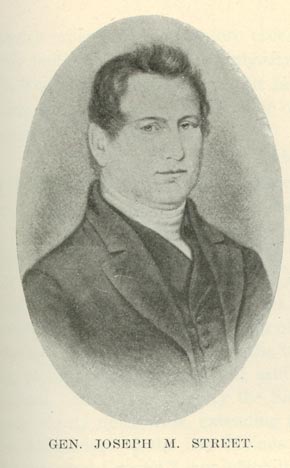
Neapope (Na-pope meaning "Broth" in the Sauk language) was a spiritual leader of the Sauk tribe and advisor to Black Hawk during the Black Hawk War.

Neapope (Na-pope meaning "Broth" in the Sauk language) was a spiritual leader of the Sauk tribe and advisor to Black Hawk during the Black Hawk War.
A prominent chieftain of the Sauk prior to the Black Hawk War, Neapope was first consulted by Black Hawk in 1820 on whether to declare war against neighboring American settlers or to move his supporters, including Neapope and Sauk chieftain Keokuk, from Illinois and into Iowa. Although Neapope advised a confederacy, including the Winnebago and Potowatomi in particular, to help defend Black Hawk's tribe, no chieftains would agree to an alliance. Neapope also travelled to Malden, Ontario in an attempt to gain British support from General Gaines, however Gaines declined stating the American settlers had a legal right to the land and advised Black Hawk to remain at peace with local settlers. Returning from Canada, Neapope stopped at the camp of the Winnebago Prophet, Wabokieshiek, where he was assured of support before returning to Black Hawk.
As fighting began, Neapope served throughout the war as one of Black Hawk's leading allies, most notably during the Battle of Wisconsin Heights (near present-day Sauk City, Wisconsin) where he successfully held off local militia while allied forces were able to escape across the Wisconsin River. Near the end of the war, Neapope was captured by Black Hawk rival Keokuk, who cooperated with American settlers but was imprisoned with Black Hawk until their release several weeks later by President Andrew Jackson and eventually rejoined the Sauks in Iowa.

The Sauk or Sac are a group of Native Americans of the Eastern Woodlands culture group, who lived primarily in the region of what is now Green Bay, Wisconsin, when first encountered by the French in 1667. Their autonym is oθaakiiwaki, and their exonym is Ozaagii(-wag) in Ojibwe. The latter name was transliterated into French and English by colonists of those cultures. Today they have three federally recognized tribes, together with the Meskwaki (Fox), located in Iowa, Oklahoma and Kansas.

The Black Hawk War was a conflict between the United States and Native Americans led by Black Hawk, a Sauk leader. The war erupted after Black Hawk and a group of Sauks, Meskwakis (Fox), and Kickapoos, known as the "British Band", crossed the Mississippi River, to the U.S. state of Illinois, from Iowa Indian Territory in April 1832. Black Hawk's motives were ambiguous, but he was apparently hoping to reclaim land that was taken over by the United States in the disputed 1804 Treaty of St. Louis.

The Ho-Chunk, also known as Hocąk, Hoocągra, or Winnebago, are a Siouan-speaking Native American people whose historic territory includes parts of Wisconsin, Minnesota, Iowa, and Illinois. Today, Ho-Chunk people are enrolled in two federally recognized tribes, the Ho-Chunk Nation of Wisconsin and the Winnebago Tribe of Nebraska.

Keokuk was a leader of the Sauk tribe in central North America, and for decades was one of the most recognized Native American leaders and noted for his accommodation with the U.S. government. Keokuk moved his tribe several times and always acted as an ardent friend of the Americans. His policies were contrary to fellow Sauk leader Black Hawk, who led part of their band to defeat in the Black Hawk War, was later returned by U.S. forces to Keokuk's custody, and who died a decade before Keokuk.

Black Hawk, born Ma-ka-tai-me-she-kia-kiak, was a Sauk leader and warrior who lived in what is now the Midwestern United States. Although he had inherited an important historic sacred bundle from his father, he was not a hereditary civil chief. Black Hawk earned his status as a war chief or captain by his actions: leading raiding and war parties as a young man and then a band of Sauk warriors during the Black Hawk War of 1832.

The Black Hawk Purchase, also known as the Forty-Mile Strip or Scott's Purchase, extended along the West side of the Mississippi River from the north boundary of Missouri North to the Upper Iowa River in the northeast corner of Iowa. It was fifty miles wide at the ends, and forty in the middle, and is sometimes called the "Forty-Mile Strip". The land, originally owned by the Sauk, Meskwaki (Fox), and Ho-Chunk (Winnebago) Native American people, was acquired by treaty following their defeat by the United States in the Black Hawk War. After being defeated the Sauk and Mesquakie were forced to relinquish another 2.5 million hectares or and give up their rights to plant, hunt, or fish on the land. The purchase was made for $640,000 on September 21, 1832 and was named for the chief Black Hawk, who was held prisoner at the time the purchase was completed. The Black Hawk Purchase contained an area of 6 million acres (24,000 km²), and the price was equivalent to 11 cents/acre. The region is bounded on the East by the Mississippi River and includes Dubuque, Fort Madison, and present-day Davenport.

The Bad Axe Massacre was a massacre of Sauk (Sac) and Fox Indians by United States Army regulars and militia that occurred on August 1–2, 1832. This final scene of the Black Hawk War took place near present-day Victory, Wisconsin, in the United States. It marked the end of the war between white settlers and militia in Illinois and Michigan Territory, and the Sauk and Fox tribes under warrior Black Hawk.

Waukon Decorah, also known as Wakąhaga (Wau-kon-haw-kaw) or "Snake-Skin", was a prominent Ho-Chunk (Winnebago) warrior and orator during the Winnebago War of 1827 and the Black Hawk War of 1832. Although not a hereditary chief, he emerged as a diplomatic leader in Ho-Chunk relations with the United States.

The St. Vrain massacre was an incident in the Black Hawk War. It occurred near present-day Pearl City, Illinois, in Kellogg's Grove, on May 24, 1832. The massacre was most likely committed by Ho-Chunk warriors who were unaffiliated with Black Hawk's band of warriors. It is also unlikely that the group of Ho-Chunk had the sanction of their nation. Killed in the massacre were United States Indian Agent Felix St. Vrain and three of his companions. Some accounts reported that St. Vrain's body was mutilated.

The Battle of Wisconsin Heights was the penultimate engagement of the 1832 Black Hawk War, fought between the United States state militia and allies, and the Sauk and Fox tribes, led by Black Hawk. The battle took place in what is now Dane County, near present-day Sauk City, Wisconsin. Despite being vastly outnumbered and sustaining heavy casualties, Black Hawk's warriors managed to delay the combined government forces long enough to allow the majority of the Sauk and Fox civilians in the group to escape across the Wisconsin River. This reprieve was temporary; when the militia finally caught up with the fleeing band it resulted in the Bad Axe massacre at the mouth of the Bad Axe River.

Shabbona or Shab-eh-nay, sometimes referred to as Shabonee and Shaubena, was an Ottawa tribe member who became a chief within the Potawatomi tribe in Illinois during the 19th century.
The Sinsinawa Mound raid occurred on June 29, 1832, near the Sinsinawa mining settlement in Michigan Territory. This incident, part of the Black Hawk War, resulted in the deaths of two men; a third man survived by seeking cover in a nearby blockhouse. In the aftermath of the raid, Captain James W. Stephenson set out to pursue the attackers—a straggling band of Sauk Native Americans—but lost their trail at the Mississippi River. The attack occurred in the same week as other skirmishes and raids, and as a result helped contribute to the growing fear in the region. The raid caused the residents of nearby Platteville to consider fleeing their settlement.
The Plum River raid was a bloodless skirmish that occurred at present-day Savanna, Illinois, on May 21, 1832, as part of the Black Hawk War. Most of the settlement's inhabitants, except for a few defenders, had fled for Galena, Illinois, before the raid happened. A small band of Native Americans, either Sauk or Fox, attacked the settlement while only three of the six defenders were present. The men who were present fell back to the blockhouse and a firefight ensued for about one hour, after which the attackers withdrew. No one was killed or injured during the attack, but in its aftermath Colonel James M. Strode dispatched a detachment of militia to Savanna. They returned to Galena without incident and the settlement at Savanna was temporarily abandoned.

Wabokieshiek was a Native American army commander of the Ho-Chunk (Winnebago) and Sauk tribes in 19th century Illinois, playing a key role in the Black Hawk War of 1832. Known as a medicine man and prophet, he is sometimes called the Winnebago Prophet.

The British Band was a mixed-nation group of Native Americans commanded by the Sauk leader Black Hawk, which fought against Illinois and Michigan Territory militias during the 1832 Black Hawk War. The band was composed of about 1,500 men, women, and children from the Sauk, Meskwaki, Fox, Kickapoo, Potawatomi, Ho-Chunk, and Ottawa nations; about 500 of that number were warriors. Black Hawk had an alliance with the British that dated from the War of 1812, giving them their colloquial name. The band crossed the Mississippi River from Iowa into Illinois in an attempt to reclaim their homeland and in violation of several treaties. Subsequently, both the Illinois and Michigan Territory militia were called up and the Black Hawk War ensued.
Alexander Posey was an American militia officer who served as a brigadier general under General Henry Atkinson during the Black Hawk War, specifically in the later stages of the second campaign as one of the commanders present at the Battle of Bad Axe.
Ebenezer Brigham was a 19th-century American pioneer, businessman, and politician. He was one of the first Americans to explore southwestern Wisconsin and the first permanent settler in present-day Dane County, Wisconsin. A militia officer during the Black Hawk War, he served as commander of Fort Blue Mounds and was active in both the Wisconsin territorial council, and the Wisconsin State Assembly during the 1840s and 1850s.

General Joseph Montfort Street was a 19th-century American pioneer, trader and US Army officer. During the 1820s and 1830s, he was also a U.S. Indian Agent to the Winnebago and later to the Sauk and Fox tribes after the Black Hawk War. His eldest son was Joseph H. D. Street, the first appointed registrar of the Council Bluffs Land Office in western Iowa.

Keokuk's Reserve was a parcel of land in the present-day U.S. state of Iowa that was retained by the Sauk and Fox tribes in 1832 in the aftermath of the Black Hawk War. The tribes stayed on the reservation only until 1836 when the land was ceded to the United States, and the Native Americans were moved to a new reservation.
The New Purchase of 1842 is a treaty between the United States and the Sauk and Meskwaki tribes, referred to as the Sac and Fox in the treaty. The Native American tribes ceded land in Iowa west of the Mississippi River and north of the Missouri border.